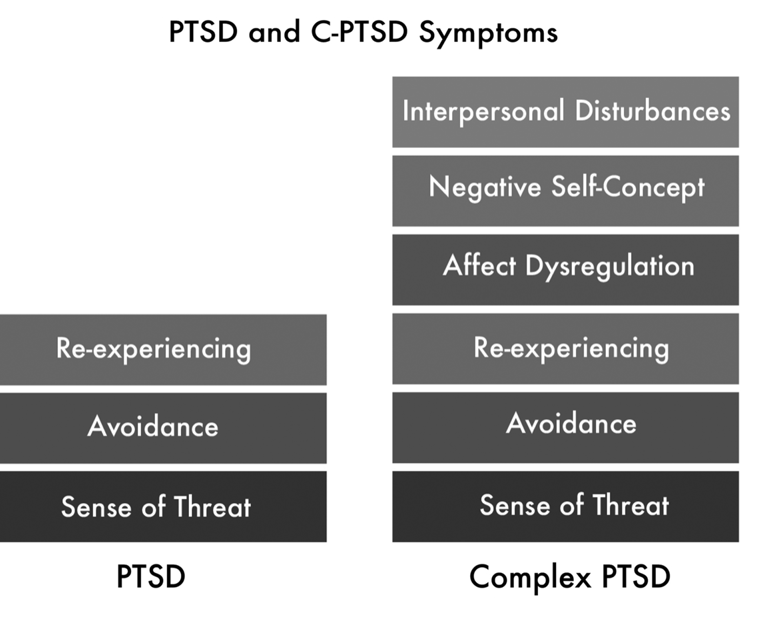What is Complex PTSD?
What is the difference between post traumatic stress disorder (PTSD) and complex post traumatic stress disorder (CPTSD)? And do you have it?
As a non-pathologizing therapist, I do not strictly adhere to diagnostic terms in a way that creates harmful identifications; however, diagnostic terms and assessments can be a useful way to narrow down or enlighten you about what is happening for you and can help to create a sense of understanding of your struggles.
Defining PTSD and C-PTSD
Post Traumatic Stress Disorder (PTSD ) is a fear-based disorder where there is a looming sense of threat. There may be flashbacks and nightmares of a traumatic event and symptoms manifest in avoidance of people, places and things as well as hypervigilance and startling. PTSD is associated with shorter-term traumatic exposure.
Complex Post Traumatic Stress Disorder (C-PTSD), aka complex trauma, attachment trauma, developmental trauma is linked to prolonged and repeated traumas and manifests both with the symptoms of PTSD, as well as challenges in self-organization and emotional regulation, negative self-concept, such as worthlessness and guilt and relational difficulties where you might feel chronically disconnected from others.
If you grew up in an environment where you felt chronically under threat, abuse, neglect, emotionally distant and unavailable, walking on eggshells and generally unsafe, with a chronic feeling of fear or helplessness, you may have some of the manifestations of C-PTSD. Feeling unsafe does not have to mean your caregivers were physically or sexually abusive, it can mean you were not extended the care and compassion to help you navigate and understand your emotions, as a result of your caregivers being disengaged and emotionally unavailable. In essence, C-PTSD can impact you if you grew up not feeling accepted, loved or understood and you experience the effects of that in your day-to-day life.
Two main risk factors for C-PTSD are:
The inability to escape the trauma.
A lack of external support systems.
If you experienced feeling unsafe, unseen, misunderstood or chronically disregarded at some period of your life, for an extended period of time, and you couldn't do much to change your situation and didn't have other support, it is quite understandable that you would have challenges in relationships, challenges regulating your emotions and a diminished sense of self. You may find yourself locked into very strong protective and defensive patterns and strategies as a means to cope. Those protective patterns can range from withdrawing and checking out to avoid situations and people or chronically putting others' needs before your own. You may feel as though other people do not meet your needs, and you feel regularly disappointed in others.
Is it possible to develop C-PTSD later in life?
You can develop C-PTSD symptoms later in life through chronic repeated traumas, domestic violence, narcissistic abuse, racism, being held against your will or other means. If you have experienced long-term exposure to feeling threatened, you are at risk of developing C-PTSD.
How can therapy help you heal from C-PTSD?
NARM (NeuroAffective Relational Model) is a cutting-edge approach to healing complex trauma, especially the kind that stems from early relational and developmental wounds. Rather than focusing on re-living traumatic memories, NARM emphasizes present-moment awareness, helping clients regulate their nervous systems and gently unwind the survival patterns—like shame, self-rejection, or people-pleasing—that once helped them cope. Rooted in curiosity and compassion, NARM supports clients in reconnecting with their authentic selves, fostering a deeper sense of agency, self-worth, and the capacity for meaningful connection.
“The spontaneous movement in all of us is toward connection, health, and aliveness. No matter how withdrawn and isolated we have become, on the deepest level, just as a plant spontaneously moves toward sunlight, there is in each of us an impulse toward connection and healing.”
- Laurence Heller and Aline LaPierre from Healing Developmental Trauma
References
Schwartz, A. (2021) The Complex PTSD Treatment Manual: An Integrative, Mind-Body Approach to Trauma Recovery
Cloitre, M., Garvert, D. W., Weiss, B., Carlson, E. B., & Bryant, R. A. (2014). Distinguishing PTSD, complex PTSD, and borderline personality disorder: A latent class analysis. European journal of psychotraumatology, 5(1), 25097.




